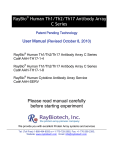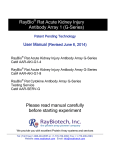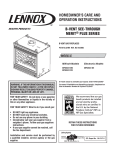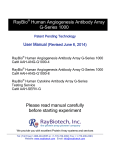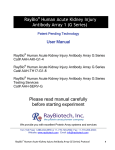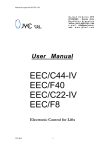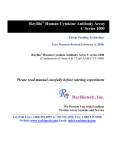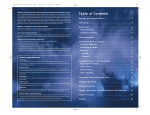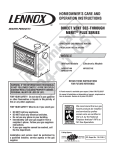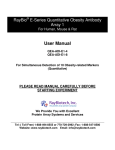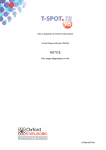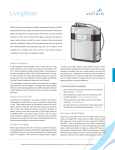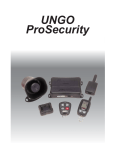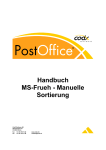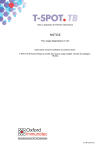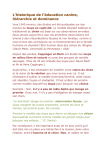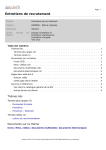Download Please read manual carefully before starting
Transcript
RayBio® Rat Acute Kidney Injury Antibody Array 1 (C-Series) Patent Pending Technology User Manual RayBio® Rat Acute Kidney Injury Antibody Array C-Series Cat# AAR-AKI-1-4 RayBio® Rat Acute Kidney Injury Antibody Array C-Series Cat# AAR-AKI-1-8 RayBio® Rat Cytokine Antibody Array Service Cat# AAR-SERV Please read manual carefully before starting experiment We provide you with excellent Protein Array systems and services Tel: (Toll Free) 1-888-494-8555 or +1-770-729-2992; Fax: +1-770-206-2393; Website: www.raybiotech.com Email: [email protected] RayBiotech, Inc., the Protein Array Pioneer Company, strives to research and develop new products to meet demands of the biomedical community. RayBiotech’s patent-pending technology allows detection of up to 1000 cytokines, chemokines and other proteins in a single experiment. Our format is simple, sensitive, reliable and cost effective. Our product offerings include: 1. Protein (antigen) Arrays 2. Cytokine Antibody Arrays (Human, Mouse, Rat and Porcine) o C-Series (Membrane, chemiluminescence detection) o G-Series (Glass chip, fluorescence detection) 3. Pathway- and Disease-focused antibody arrays o Angiogenesis Antibody Arrays o Apoptosis Antibody Arrays o Atherosclerosis Antibody Arrays o Chemokine Antibody Arrays o Growth Factor Antibody Arrays o Inflammation Antibody Arrays o MMP Antibody Arrays o Obesity Antibody Arrays 4. Quantibody® Multiplex ELISA Arrays 5. L-Series Biotin Label-based Antibody Arrays 6. Phosphorylation Antibody Arrays o Receptor Tyrosine Kinases o EGFR and ErbB family (site-specific phosphorylation) 7. Over 700 different ELISA kits 8. EIA kits 9. Cell-based phosphorylation assay 10. Over 10,000 different Antibodies 11. Recombinant proteins 12. Peptide 13. Recombinant antibodies Protocol for RayBio® Rat Acute Kidney Injury Antibody Array 1 (C Series) TABLE OF CONTENTS I. Introduction···················································································1 II. Product Information································································3 A. Storage Recommendations·····································3 B. Materials Provided··························································4 C. Additional Materials Required································4 D. How It Works·······································································5 III. Helpful Tips and General Considerations·············5 A. Preparation and Storage of Samples···············5 B. Handling Array Membranes·····································7 C. Incubations and Washes···········································7 D. Chemiluminescence Detection·····························8 IV. Protocol···························································································8 A. Preparation and Storage of Reagent···············8 B. Blocking and Incubations··········································9 C. Chemiluminescence Detection··························10 V. Interpretation of Results··················································12 VI. Antibody Array Maps·························································15 VII. Troubleshooting Guide····················································16 VIII. Selected References·························································17 RayBio® Cytokine Antibody Arrays are patent-pending technology. RayBio® is the trademark of RayBiotech, Inc. RayBio® Rat Acute Kidney Injury Antibody Array 1 (C Series) Protocol 0 I. Introduction New techniques such as cDNA microarrays have enabled us to analyze global gene expression1-3. However, almost all cell functions are executed by proteins, which cannot be studied simply through DNA and RNA techniques. Experimental analysis clearly shows disparity can exist between the relative expression levels of mRNA and their corresponding proteins4. Therefore, analysis of the proteomic profile is critical. RayBiotech, The Protein Array Pioneer Company, introduced the first protein arrays to the market in 2001 and continues to lead in the development of innovative protein array technologies, such as the RayBio Rat Acute Kidney Injury Antibody Array. Acute kidney injury is a common complication among ambulatory and hospitalized patients. It is a rapidly progressive illness that independently predicts excess morbidity and mortality. It is critical to early detect acute kidney injury and distinguish it from prerenal azotemia and chronic kidney disease at the time of patient presentation to rapidly manage associated illness. However, serum creatinine, a standard marker of kidney function, does not distinguish acute kidney injury from prerenal azotemia5 or chronic kidney disease. In addition, the initial measurement of serum creatinine cannot reflect the extent of injury because its accumulation always lags behind the insult6. The kidney is the primary organ responsible for the excretion of medications and their biotransformation products from the body. Rats are widely used for probing pharmacokineticpharmacodynamic (PK-PD) relationships for medications; in addition, rats have been demonstrated to be a useful model for evaluating mechanisms of kidney toxicity. In recent years, numerous molecules have been described and investigated as candidate biomarkers of kidney injury. The United States Food and Drug Administration (FDA) has taken an active role in developing a process for qualification of biomarkers7, 8 that would potentially improve the drug development and regulatory review process. In the gentamicin-induced rat model of acute kidney RayBio® Rat Acute Kidney Injury Antibody Array 1 (C Series) Protocol 1 injury, based on histopathology, necrosis, or apoptosis scoring, kidney injury molecule-1 (KIM-1) was the best biomarker of overall renal injury9. Traditionally, urine proteins or cytokines are detected by using ELISA. However, RayBio® Rat Acute Kidney Injury Antibody Array C-Series can detect 7 protein biomarkers simultaneously with a small amount of sample. It is a great tool in the acute kidney injury research areas and drug discovery area to hasten drug development. 1. Tang X, Marciano DL, Leeman SE, Amar S. LPS induces the interaction of a transcription factor, LPS-induced TNF-a factor, and STAT6(B) with effects on multiple cytokines. PNAS. 2005; 102(14): 5132-5137. 2. Xu Y, Kulkosky J, Acheampong E, Nunnari G, Sullivan J, Pomerantz RJ. HIV-1-mediated apoptosis of neuronal cells: Proximal molecular mechanisms of HIV-1-induced encephalopathy. PNAS. 2004; 101(18): 7070-7075. 3. El-Hage N, Gurwell JA, Singh IN, Knapp PE, Nath A, Hauser KF. Synergistic increases in intracellular Ca(2+), and the release of MCP-1, RANTES, and IL-6 by astrocytes treated with opiates and HIV-1 Tat. Glia. 2005; 50(2):91-106. 4. Oh HS, Moharita A, Potian JG, Whitehead IP, et al. Bone Marrow Stroma Influences Transforming Growth Factor-β Production in Breast Cancer Cells to Regulate c-myc Activation of the Preprotachykinin-I Gene in Breast Cancer Cells. Cancer Res. 2004; 64: 6327-6336. 5. Bonventre JV, Weinberg JM. Recent advances in the pathophysiology of ischemic acute renal failure. J Am Soc Nephrol. 2003; 14:2199–210. 6. Lameire N, Hoste E. Reflections on the definition, classification, and diagnostic evaluation of acute renal failure [Editorial]. Curr Opin Crit Care. 2004; 10:468–75. 7. Goodsaid F, Frueh F. Biomarker qualification pilot process at the US Food and Drug Administration. AAPS J 2007; 9: E105–E108. 8. Goodsaid FM, Frueh FW, Mattes W. Strategic paths for biomarker qualification. Toxicology 2008; 245: 219–223. RayBio® Rat Acute Kidney Injury Antibody Array 1 (C Series) Protocol 2 9. Rodney L. Rouse, Jun Zhang, Sharron R. Stewart, Barry A, Rosenzweig, Parvaneh Espandiari, and Nakissa K. Sadrieh3. Comparative profile of commercially available urinary biomarkers in preclinical drug-induced kidney injury and recovery in rats. Kidney International (2011) 79, 1186–1197 II. Product Information A. Storage Recommendations: For best results, store the entire kit at –20°C or –80°C upon arrival. If stored frozen, we recommend using the kit within 6 months, which is the duration of the product warranty period. Once thawed, store array membranes and 1X Blocking Buffer at –20°C or –80°C, and all other component at 4°C. After thawing, the entire kit should be used within 3 months. Array kits are robust and will retain full activity even if stored for up to 24 hours at room temperature. RayBio® Rat Acute Kidney Injury Antibody Array 1 (C Series) Protocol 3 B. Materials Provided AARAKI-1-4 AARAKI-1-8 ® RayBio Rat AKI Antibody AAR-AKI1-Y Array Membranes* 0103002- R-AKI -1 Biotin-Conjugated AntiCytokines 1,000X HRP-Conjugated 0103004-H Streptavidin 0103004-B 1X Blocking Buffer 0103004-W † 20X Wash Buffer I † 0103004-W † 20X Wash Buffer II † 1 or 2 paks* 2 paks* 2 ea 4 ea 1 ea 25 ml 10 ml 10 ml 1 ea 50 ml 20 ml 20 ml 0103004-D † 0103004-D † 0103004-T 1.5 ml 1.5 ml 1 2.5 ml 2.5 ml 1 Item Description Detection Buffer C † Detection Buffer D † 8-Well Plastic Tray Other Kit Components: 8-well Tray, Plastic sheets, Manual, Array Template, Packing list * Packs contains 2 or 4 arrays each † Wash Buffers and Detection Buffers are sold as Sets Y = 4 or 8 C. Additional Materials Required • Small plastic boxes or containers • Pipettors, pipet tips and other common lab consumables • Orbital shaker or oscillating rocker • Saran Wrap or similar plastic film • A chemiluminescent blot documentation system (such as UVP’s ChemiDoc-It® or EpiChem II Benchtop Darkroom), X-ray Film and a suitable film processor, or other chemiluminescent detection system. RayBio® Rat Acute Kidney Injury Antibody Array 1 (C Series) Protocol 4 D. How It Works III. Helpful Tips and General Considerations A. Preparation and Storage of Samples 1. General Considerations: • Freeze samples as soon as possible after collection. • Avoid multiple freeze-thaw cycles. If possible, sub-aliquot your samples prior to initial storage. • Spin samples hard (5-10 minutes at 10K to 15K RPM) immediately prior to incubation of samples with array. • Optimal sample concentrations may need to be determined empirically based on the signal intensities of spots and background signals obtained with each sample. • If spot intensities are weak, increase sample concentration in subsequent experiments. • If background or spot intensities are too strong, decrease sample concentration in subsequent experiments. RayBio® Rat Acute Kidney Injury Antibody Array 1 (C Series) Protocol 5 • Most samples will not need to be concentrated. If concentration is required, we recommend using a spincolumn concentrator with a chilled centrifuge. 2. Recommended Sample Volumes and Dilution Factors NOTE: All sample dilutions should be made using the 1X Blocking Buffer provided in this kit. For all sample types, final sample volume = 1.0-1.2 mL per membrane • Urine 2-fold to 5-fold dilution Note: If the sample volume is less than 200µl, the membrane and sample may be sealed in a small plastic bag to increase sample-membrane coverage. Expel all air bubbles prior to sealing bag. Note: The RayBio® Rat Acute Kidney Injury Antibody Array is intended for use with Rat Urine samples. However, if you wish, you may test other sample types as follows: • Serum & Plasma: 2-fold to 5-fold dilution 3. Preparing Urine: • Prepare 200µl aliquots and store at –20°C or –80°C as soon as possible after collecting urine samples. • Addition of protease inhibitors is not required. • Immediately prior to sample incubation (Step 3 of protocol), spin samples at 1000 rpm for 10 minutes to remove particulates and precipitates. 4. Preparing Serum/Plasma: • Prepare samples according to established protocols or collection tube manufacturer’s instructions. Sub-aliquot into plastic tubes. Store at –20°C or –80°C. • We do not recommend comparing results between serum and plasma samples or between plasma prepared using different anticoagulants. RayBio® Rat Acute Kidney Injury Antibody Array 1 (C Series) Protocol 6 • For most applications, you may test plasma samples prepared using any anticoagulant (i.e., Heparin, EDTA or Citrate). However, EDTA-prepared plasma may interfere with detection of MMPs and other metal-binding proteins. • If possible, avoid testing hemolyzed serum or plasma, as these samples may generate anomalous cytokine expression patterns and/or high background signals. B. Handling Array Membranes • Array membranes are fragile when dry. Handle with care. • Wet or dry, grasp membranes by the edges using forceps. • Do not allow membranes to dry out during experiments. • The printed side of each membrane is denoted by a dash mark (-) or array number in the upper left corner. C. Incubations and Washes • All washes and incubations in the standard protocol can be performed using the 8-well tray provided in the kit. • Place the cover on 8-well trays with lid to avoid drying, particularly during extended incubation or wash steps. • During each incubation, be sure to completely cover the membranes with sample or reagent. • During incubation steps, avoid foaming and be sure to remove all bubbles from the membrane surface. • Perform all incubation and wash steps under gentle rotation or rocking motion (≈0.5 to 1 cycles/second). • Wash steps in Wash Buffer II and all incubation steps may be performed overnight at 4°C. Overnight sample incubations are the most effective at increasing antigenspecific spot intensities. • If you perform overnight sample incubations, we recommend adding the optional “Large Volume Wash” described in Step 4 to minimize background signals. • Overnight blocking and wash steps are useful for reducing background signal intensities. Wash steps may be repeated even with completed membranes to reduce background signals. Wash with Wash Buffer II, followed by repeating incubation with Streptavidin-HRP and chemiluminescent RayBio® Rat Acute Kidney Injury Antibody Array 1 (C Series) Protocol 7 detection may greatly improve signal-to-noise ratios in your developed array images. D. Chemiluminescence Detection • We strongly recommend using multiple exposures to obtain optimum images. Begin by exposing the membranes for 40 seconds. Then re-expose the film accordingly. • If the signals are too strong (or background is too high), reduce exposure time (e.g., 5-30 seconds). • If the signals are weak, increase exposure time. • Gel/blot documentation systems that use CCD cameras to detect chemiluminescence are ideal for imaging RayBio® array membranes. They can easily be programmed to take multiple exposures, and the dynamic range of these detectors tends to be 2-3 orders of magnitude greater than X-ray film. IV. Protocol A. Preparation and Storage of Reagents NOTE: During this protocol, prepare reagents immediately prior to use and keep working dilutions of all reagents on ice at all times. 1. Blocking Buffer is supplied as 1X concentration, no reconstitution or dilution is required. Store at –20°C or –80°C when not in use. 2. Wash Buffers I and II (Item# 0103004-W) are supplied as 20X. a). For each membrane, dilute 1 mL of Wash Buffer I with deionized water to a final volume of 20 mL. b). For each membrane, dilute 1 mL of Wash Buffer II with deionized water to a final volume of 20 mL. c). 1X Wash Buffers can be stored at 4°C for up to 1 month. 20X Wash Buffers can be stored 4°C for up to 3 months. 3. Biotin-Conjugated Anti-Cytokines are supplied at 2000X concentration as a small liquid bead (typically ≈2-5 μL). RayBio® Rat Acute Kidney Injury Antibody Array 1 (C Series) Protocol 8 Note: Spin down the tube prior to reconstitution, as the concentrated liquid bead may have moved to the top of the tube during handling. a). Add 100 μL 1X Blocking Buffer to the tube containing 2000X Biotin-Conjugated Anti-Cytokines. b). Mix well and quantitatively transfer stock reagent to larger tube containing 1900 μL of 1X Blocking Buffer. c). 1X Biotin-Conjugated Anti-Cytokines may be stored for 2-3 days at 4°C. 4. Streptavidin-HRP is supplied as 1000X concentration. a). Mix the tube containing 1,000X Streptavidin-HRP well before use, as precipitates may form during storage. b). Add 2 μL of 1000X Streptavidin-HRP to 1998 μL of 1X Blocking Buffer. c). This working dilution can be stored for 3-5 days at 4°C. 5. Detection Buffers C & D are supplied as 1X solutions that are intended to be mixed in a 1:1 ratio immediately prior use. Detection reagents may be stored at 4°C for up to 3 months. B. Blocking and Incubations NOTE: Please prepare all reagents immediately prior to use as described above (Section IV.A) and carefully read tips on Sample Preparation (Section III.A) and Incubations and Washes (Section III.C) before proceeding. 1) Place each membrane printed side up (see Section III.B) into the 8-well tray provided in the kit. 2) Block membranes by incubating with 2 mL 1X Blocking Buffer at room temperature (RT) for 30 min. 3) Decant Blocking Buffer, and incubate membranes with 1 mL of sample at RT for 1-2 h. RayBio® Rat Acute Kidney Injury Antibody Array 1 (C Series) Protocol 9 4) Aspirate samples from membranes. Wash 3 times, 5 min per wash, with 2 mL Wash Buffer I at RT. Use fresh buffer for each wash. OPTIONAL Large Volume Wash: After Step 4, place membranes into clean container(s). Add 20-30 mL of Wash Buffer I per membrane, and wash at RT with gentle shaking or rocking for 30-45 min. Return membranes to the 8-well tray. Then proceed to Step 5. 5) Wash 2 times, 5 min per wash, with 2 mL of 1X Wash Buffer II each at RT. Use fresh wash buffer each time. 6) Add 1 mL of 1X Biotin-conjugated Anti-Cytokines to each membrane. Incubate at RT for 1-2 hours. 7) Decant or aspirate Anti-Cytokine reagent and repeat washes as described in steps 4 and 5 above. 8) Incubate at RT for 2 hours with 1 mL of 1X Streptavidin-HRP. 9) Wash membranes as directed in steps 4 and 5. 10) Proceed with Detection protocol (below) or store membranes between plastic sheets (provided in kit) as directed in Steps 20 & 21 below. C. Chemiluminescence Detection NOTE: Do not allow membranes to dry out during detection. Detection of chemiluminescence should be started within 5 minutes after removing Detection Buffers and must be completed within 20 minutes. 11) Place a plastic sheet (provided in the kit) on your benchtop. 12) Place one or more array membranes protein side up (see Section III.B) on the plastic sheet. Drain excess liquid by touching one edge to blotting paper or tissue paper. RayBio® Rat Acute Kidney Injury Antibody Array 1 (C Series) Protocol 10 13) Into a single, clean tube add equal volumes of Detection Buffer C and Detection Buffer D immediately prior to detection. Mix well. Add 250 μL of each buffer per membrane to be detected, e.g., for 4 membranes, combine 1 mL of each detection buffer. 14) Pipette the mixed Detection Buffers onto each membrane. Place another plastic sheet on top, starting at one end and “rolling” the flexible plastic across the surface to the opposite end. During this process, ensure that the detection mixture completely covers each membrane, and gently smooth out any air bubbles. Avoid sliding the plastic sheet along the membranes’ printed surfaces. 15) Incubate at RT for 2 minutes. 16) Remove top plastic sheet and aspirate excess liquid (see Step 12). 17) Gently replace the membranes (protein side up) on the bottom plastic sheet and replace the top plastic sheet (see Step 14). Gently smooth out any air bubbles on the membrane surfaces. 18) Detect signals using a chemiluminescence imaging system or expose the array membranes to x-ray film (we recommend Kodak’s X-Omat™ AR film) and develop the film (See tips for obtaining array images in Section III.D). 19) For each array, use multiple exposures to obtain an image with low background and strong Positive Control signals that do not bleed into one another. Typical exposure times are 10 seconds to 2 min. 20) When you finish your last exposure, remove the top plastic sheet. Gently rinse membranes and plastic sheets with Wash Buffer II. Remove excess wash buffer as described in Step 14, and replace the membranes between the plastic sheets. RayBio® Rat Acute Kidney Injury Antibody Array 1 (C Series) Protocol 11 21) Wrap the sheets in Saran Wrap, and store the membranes at –20°C to –80°C. (Or store membranes for up to 5 days at 4°C in Wash Buffer II. Cover the container to avoid evaporation.) V. Interpretation of Results: Typical results obtained with RayBio® C Series Antibody Arrays Sample-1 Sample-2 Control The preceding figure presents typical images obtained with RayBio® Human Cytokine Antibody Array. These membranes were probed with conditioned media from two different cell lines. Membranes were exposed to Kodak X-Omat® film at RT for 1 min. Note the strong signals of the Positive Control spots, provided by biotin-conjugated IgG printed directly onto the array membrane in the upper-left and lower-right corners. These Positive Control spots are useful for proper orientation of the array image. The signal intensity for each antigen-specific antibody spot is proportional to the relative concentration of the antigen in that sample. Comparison of signal intensities for individual antigenspecific antibody spots between and among array images can be used to determine relative differences in expression levels of each analyte sample-to-sample or group-to-group. Obtaining Densitometry Data: Visual comparison of array images may be sufficient to see differences in relative protein expression. However, most researchers will want to perform numerical comparisons of the signal intensities (or more precisely, signal densities), using 2-D RayBio® Rat Acute Kidney Injury Antibody Array 1 (C Series) Protocol 12 densitometry. Gel/Blot documentation systems and other chemiluminescent or phosphorescent detection systems are usually sold as a package with compatible densitometry software. To obtain densitometry data from an X-ray film, one must first scan the film to obtain a digitized image using an ordinary office scanner with resolution of 300 dpi or greater. Any densitometry software should be sufficient to obtain spot signal densities from your scanned images. One such software program, ImageJ, is available for free from the NIH (for more info, visit http://rsbweb.nih.gov/ij/). We suggest using the following guidelines when extracting densitometry data from our array images: • • • For each array membrane, identify a single exposure that the exhibits low background signal intensity and strong Positive Control signals that do not “bleed” into one another. Exposure times do not need to be identical for each array, but Positive Control signals on each image should have similar intensities. Measure the density of each spot using a circle that is roughly the size of one of the largest spots. Be sure to use the same circle (area and shape) for measuring the signal densities on every array for which you wish to compare the results. For each spot, use the summed signal density across the entire circle (i.e., total signal density per unit area) Before analysis, subtract the background from raw densitometry data and normalize the signal intensities to the Positive Controls. Background Subtraction: On each array, several “Negative Control” and/or “Blank” spots will be included. Blank spots are literally blank; nothing has been printed there. Negative Control spots are printed with the same buffer used to dilute antibodies printed on the array. Thus, the signal intensities of the Negative Controls represent the RayBio® Rat Acute Kidney Injury Antibody Array 1 (C Series) Protocol 13 background plus non-specific binding to the printed spots. We recommend subtracting the mean of 4 or more Negative Control spots for background correction. Normalization of Array Data: The amount of biotin-conjugated IgG protein printed for each Positive Control spot is consistent from array to array. As such the intensity of these Positive Control signals can be used to normalize signal responses for comparison of results across multiple arrays, much like housekeeping genes and proteins are used to normalize results of PCR gels and Western Blots, respectively. To normalize array data, one array is defined as "reference" to which the other arrays are normalized. This choice can be arbitrary. For example, in our Analysis Tool Software, the array represented by data entered in the first column on the left of each worksheet is the default “reference array.” You can calculate the normalized values as follows: X(Ny) = X(y) * P1/P(y) Where: P1 = mean signal density of Positive Control spots on reference array P(y) = mean signal density of Positive Control spots on Array "y" X(y) = mean signal density for spot "X" on Array for sample "y" X(Ny) = normalized signal intensity for spot "X" on Array "y" After background subtraction and normalization, you can compare signal intensities, analyte-by-analyte, among or between samples or groups to determine relative differences in cytokine expression. The RayBio® Analysis Tool software is available for use with data obtained using RayBio® Cytokine Antibody Arrays. Copy and paste your signal intensity data into the “Aligning Data” worksheet, and it will compile and organize your data, as well as automatically subtracting background signals and normalizing to RayBio® Rat Acute Kidney Injury Antibody Array 1 (C Series) Protocol 14 the Positive Controls. To order the Analysis Tool, please contact us at +1-770-729-2992 or [email protected] for more information. VI. RayBio® C Series Rat Acute Kidney Injury Antibody Array 1 Maps: Detects 7 cytokines in one experiment A B C D E F G H 1 POS POS NEG NEG Cystatin C FABP1 KIM-1 MCP-1 2 POS POS NEG NEG Cystatin C FABP1 KIM-1 MCP-1 3 NGAL TIMP-1 VEGF NEG NEG NEG NEG POS 4 NGAL TIMP-1 VEGF NEG NEG NEG NEG POS Abbreviations: POS = Positive Control, NEG = Negative Control, L-FABP = Liver Fatty-Acid Binding Protein, KIM-1 = Kidney Injury Molecule-1, NGAL= Neutrophil GelatinaseAssociated Lipocalin (Lipocalin 2). All others use standard abbreviations. RayBio® Rat Acute Kidney Injury Antibody Array 1 (C Series) Protocol 15 VII. Troubleshooting guide Problem Cause No signal for any spots, including Positive Controls Repeat incubation with Global detection failure HRP-Streptavidin and Detection Buffers Repeat experiment using Sample is too dilute higher sample concentration Tube may contain precipitants. Repeat Improper dilution of HRPdetection, mix 1000X HRPStreptavidin Streptavidin well before diluting reagent Repeat detection, making Waiting too long to detect sure to complete this chemiluminescent signals process within 20 min. Weak or no signals antigen-specific spots Incubate with sample O/N at 4°C Other Tips Uneven signal or background High background signals Recommendation Increase concentration of HRP-Streptavidin Overexposure Increase concentration of Biotin-conjugated AntiCytokine Extend exposure time (may go overnight) Be sure to completely remove all bubbles from membrane surface Completely cover membranes with solution, use a rocker or shaker during washes and incubations Decrease exposure time Sample is too concentrated Repeat experiment using more dilute sample Bubbles present on membrane during incubations Membranes were not evenly covered during washes/incubations or allowed to dry out NOTE: To reduce background on completed membrane, wash O/N @ 4°C in Wash Buffer II, then re-incubate with HRP-Streptavidin and repeat detection. RayBio® Rat Acute Kidney Injury Antibody Array 1 (C Series) Protocol 16 VIII. Selected References Featuring RayBio® C-Series Arrays 1. Ray S, Britschgi M, Herbert C, et al. Classification and prediction of clinical Alzheimer's diagnosis based on plasma signaling proteins. Nature Med. 2007; 13(11):1359-1362. 2. McAllister SS, Gifford AM, Greiner AL , et al. Systemic Endocrine Instigation of Indolent Tumor Growth Requires Osteopontin. Cell. 2008; 133: 994-1005. 3. Acosta JC, O'Loghlen A, Banito A, et al. Chemokine Signaling via the CXCR2 Receptor Reinforces Senescence. Cell. 2008; 133: 1006-1018. 4. Brown JM, Boysen MS, Chung S, et al. Conjugated Linoleic Acid Induces Human Adipocyte Delipidation: Autocrine/Paracrine Signaling by Adipokines. J Biol Chem. 2004; 279(25): 26735-26747. 5. Celis JE, Moreira JMA, Gromova I, et al. Towards discovery-driven translational research in breast cancer. FEBS J. 2004;272: 2-15. 6. Lin PW, Simon PO, Gewirtz AT, et al. Paneth Cell Cryptdins Act in Vitro as Apical Paracrine Regulators of the Innate Inflammatory Response. J Biol Chem. 2004; 279(19): 19902-19907. 7. Xu Y, Kulkosky J, Acheampong E, et al. HIV-1-mediated apoptosis of neuronal cells: Proximal molecular mechanisms of HIV-1-induced encephalopathy. PNAS. 2004; 101(18):7070-7075. 8. Tang X, Marciano DL, Leeman SE, Amar S. LPS induces the interaction of a transcription factor, LPS-induced TNF-alpha factor, and STAT6(B) with effects on multiple cytokines. PNAS. 2005; 102(14): 5132-5137. 9. Wang F-X, Xu Y, Sullivan J, et al. IL-7 is a potent and proviral strain– specific inducer of latent HIV-1 cellular reservoirs of infected individuals on virally suppressive HAART. J Clin Invest. 2005; 155: 128–137. 10. De Ceuninck F, Marcheteau E, Berger S, et al. Assessment of Some Tools for the Characterization of the Human Osteo-arthritic Cartilage Proteome. J Biomol Tech. 2005; 16: 256–265. RayBio® Rat Acute Kidney Injury Antibody Array 1 (C Series) Protocol 17 11. Boucharaba A, Serre C-M, Guglielmi J, et al. The type 1 lysophosphatidic acid receptor is a target for therapy in bone metastases. PNAS. 2006; 103(25):9643-9648. 12. Matsunaga K, Yanagisawa S, Ichikawa T, et al. Airway cytokine expression measured by means of protein array in exhaled breath condensate: Correlation with physiologic properties in asthmatic patients. J Allergy Clin Immunol. 2006; 188: 84-90. 13. Vargas DL, Nascimbene C, Chitra Krishnan C, et al. Neuroglial activation and neuroinflammation in the brain of patients with autism. Ann Neurol. 2005; 57: 67-81. 14. Miyoshi N, Oubrahim H, Chock PB, Stadtman ER. Age-dependent cell death and the role of ATP in hydrogen peroxide-induced apoptosis and necrosis. PNAS. 2006; 103(6): 1727–1731. 15. Coppinger JA, O'Connor R, Wynne K, et al. Moderation of the platelet releasate response by aspirin. Blood. 2007; 109: 4786-4792. 16. Cortez DM, Feldman MD, Mummidi S, et al. IL-17 stimulates MMP-1 expression in primary human cardiac fibroblasts via p38 MAPK- and ERK1/2-dependent C/EBP-beta, NF-kB, and AP-1 activation. Am J Physiol Heart Circ Physiol. 2007; 293: H3356-H3365. 17. Walt DR, Blicharz TM, Hayman RB, Rissin DM, et al. Microsensor Arrays for Saliva Diagnostics. Ann NY Acad Sci. 2007; 1098:389-400. RayBio® Rat Acute Kidney Injury Antibody Array 1 (C Series) Protocol 18 Customized RayBio® Cytokine Antibody Arrays. Select your cytokines of interest from the following list, and we will produce the customized array for you. For more information, please visit our website, www.raybiotech.com. 4-1BB ACE-2 Acrp30 Activin A Adiposin Adipsin AgRP ALCAM α-Fetoprotein Amphiregulin Angiogenin Angiopoietin-1 Angiopoietin-2 Angiostatin ANGPTL4 Axl B7-1 BCAM BCMA BDNF β2M β IG-H3 bFGF BLC BMP-4 BMP-5 BMP-6 BMP-7 β-NGF BTC CA125 CA15-3 CA19-9 CA IX Cardiotrophin-1 Cathepsin S CCL14a CCL21 CCL-28 CD14 CD23 CD30 CD40 CD40 Ligand CD80 CEA CEACAM-1 CK β8-1 CNTF Cripto CRP CTACK CXCL16 DAN Decorin Dkk-1 Dkk-3 Dkk-4 DPPIV DR6 Dtk E-Cadherin EDA-A2 EGF EGFR EG-VEGF ENA-78 Endoglin Eotaxin Eotaxin-2 Eotaxin-3 Ep CAM ErbB2 ErbB3 EPO R E-Selectin Fas Fas Ligand Fcr RIIB/C Ferritin FGF-4 FGF-6 FGF-6 FGF-7 FGF-9 Fit-3 Ligand FLRG Follistatin Fractalkine FSH Furin Galectin-7 GCP-2 G-CSF GDF-15 GDNF GITR GITR Ligand GM-CSF GRO (α/β/γ) GROα GH HB-EGF HCC-4 hCG (intact) HGF HVEM I-309 ICAM-1 ICAM-2 ICAM-3 IFNγ IGF-1 SR IGFBG-1 IGFBP-2 IGFBP-3 IGFBP-4 IGFBP-6 IGF-I IGF-I SR IGF-II IL-1α IL-1β IL-1 R II IL-1 R4/ST2 IL-1 RI IL-1 sRI IL-10 IL-10 Rα IL-10 Rβ IL-11 IL-12 IL-12 p40 IL-12 p70 IL-13 IL-13 Rα-2 IL-13 RI IL-15 IL-16 IL-17 IL-17B IL-17C IL-17F IL-17R IL-18 BPα IL-18 Rβ IL-1ra IL-2 IL-2 Rβ IL-2 Rγ IL-2 Ra IL-21R IL-22 IL-28A IL29 IL-3 IL-31 IL-4 IL-5 IL-5 Rα IL-6 IL-6 sR IL-7 IL-8 IL-9 Insulin IP-10 I-TAC LAP Leptin Leptin R LIF LIGHT LIMPII L-Selectin LH Lymphotactin LYVE-1 Marapsin MCP-1 MCP-2 MCP-3 MCP-4 M-CSF M-CSF R MDC MICA MICB MIF MIG MIP-1α MIP-1β MIP-1δ MIP-3α MIP-3β MMP-1 MMP-10 MMP-13 MMP-2 MMP-3 MMP-7 MMP-8 MMP-9 MPIF-1 MSPα NAP-2 NCAM-1 NGF R Nidogen-1 NrCAM NRG1-β1 NT-3 NT-4 Oncostatin M Osteopontin OPG PAI-I PARC PDGF Rα PDGF Rβ PDGF-AA PDGF-AB PDGF-BB PECAM-1 PIGF PF4 Procalcitonin Prolactin PSA-free PSA-total RAGE RANK RANTES Resistin S-100b SAA SCF SCF R SDF-1 SDF-1β RayBio® Rat Acute Kidney Injury Antibody Array 1 (C Series) Protocol SAA sgp130 Shh N Siglec-5 Siglec-9 ST2 sTNF RI sTNF RII TACE TARC TECK TGFα TGFβ1 TGFβ2 TGFβ3 TPO Thyroglobulin Tie-1 Tie-2 TIM-1 TIMP-1 TIMP-2 TIMP-4 TNFα TNFβ TNFRSF21 TNFRSF6 TRAIL R2 TRAIL R3 TRAIL R4 Trappin-2 TREM-1 TSH TSLP Ubiquitin uPAR VCAM-1 VE-Cadherin VEGF VEGF R2 VEGF R3 VEGF-C VEGF-D XEDAR 19 RayBio® Rat Acute Kidney Injury Antibody Array 1 (C Series) Protocol 20 Testing Services: RayBiotech offers full testing services using any of our Array, ELISA or EIA products, including customized products. Just send your samples, and we will send you the results. Custom Services: 1. 2. 3. 4. 5. 6. 7. 8. Customized Antibody and Protein Arrays Customized Phosphorylation Arrays Peptide synthesis Peptide arrays Recombinant protein and antibody production ELISA EIA Assay development Technology Transfer Program: Have you developed technologies or reagents of interest to the scientific and research community? RayBiotech can help you commercialize your technologies, reagents and dream. RayBio® Rat Acute Kidney Injury Antibody Array 1 (C Series) Protocol 21 RayBio® is the registered trademark of RayBiotech, Inc. The RayBio® C-Series Cytokine Antibody Array is a patentpending technology developed by RayBiotech. This product is intended for research only and is not to be used for clinical diagnosis. Our produces may not be resold, modified for resale, or used to manufacture commercial products without written approval by RayBiotech, Inc. Under no circumstances shall RayBiotech be liable for any damages arising out of the use of the materials. Products are guaranteed for 6 months from the date of purchase when handled and stored properly. In the event of any defect in quality or merchantability, RayBiotech’s liability to buyer for any claim relating to products shall be limited to replacement or refund of the purchase price. X-OmatTM is the trademark of The Kodak Company. ChemiDoc-It® is the registered trademark of UVP. This product is for research use only. ©2011 RayBiotech, Inc. RayBio® Rat Acute Kidney Injury Antibody Array 1 (C Series) Protocol 22

























